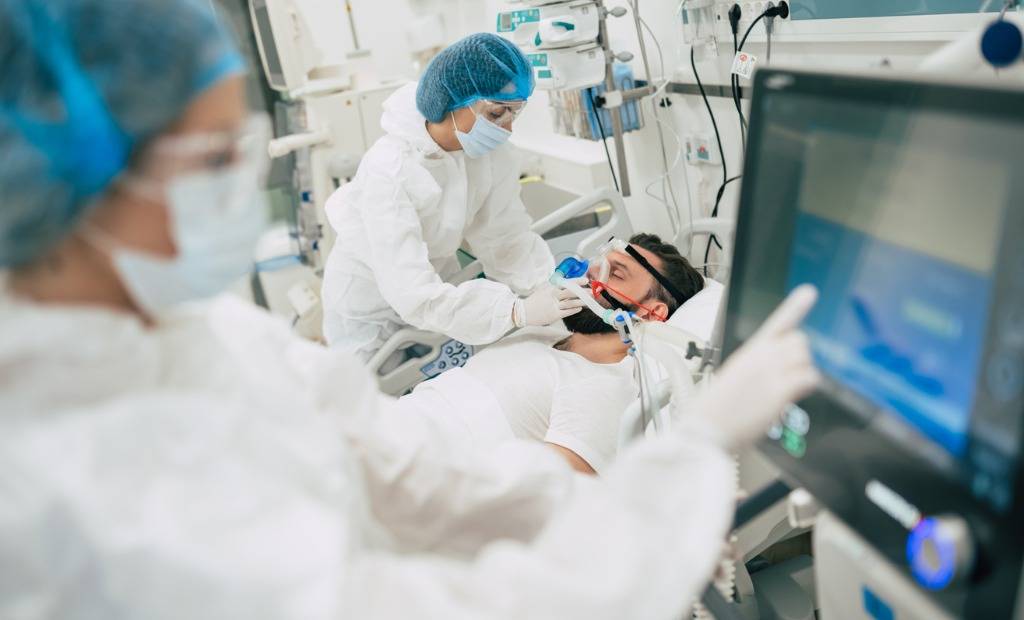Patients in critical care require around-the-clock supervision by a number of doctors, including an anesthesiologist. Anesthesiologists play a large role in critical care by monitoring pertinent vital signs, including blood oxygen saturation, blood pressure, respiratory rate, and heart rate, as well as ensuring patient comfort. Moreover, according to the Yale Medicine website, critical care anesthesiologists often serve as the liaison between other doctors to make sure care is properly coordinated.1 Given that anesthesiologists are highly trained to perform time-sensitive interventions – such as resuscitation, intubation, and pain control – the skills produced in anesthesiology training translate directly to critical care. All anesthesiologists in the U.S. are expected to complete two months of critical care training within the span of their four-year residency. A small number of anesthesiologists who frequently work in the ICU will pursue an advanced fellowship in emergency/critical care medicine – either adult, pediatric, or both. Accreditation requires an additional year of training in critical care medicine after completion of residency, with a minimum of 9 months of this time spent in the ICU. Physicians with this kind of dual training assist in medical assessment and diagnosis in addition to performing more traditional anesthetic interventions, such as respiratory and cardiovascular support or infection management.
Interestingly, anesthesiologists play a much larger role in critical care in Europe than in the United States, where less than four percent of board-certified anesthesiologists have dual training in Critical Care Medicine. Moreover, the percentage of anesthesiologist in critical care in the U.S. has steadily declined over the past ten years. 2 According to authors Hanson et al., this decline is primarily thought to be the product of the better working conditions and pay in the operative anesthesia setting. While these factors may be difficult to change, the authors point out that there are many simple ways medical students or residents could get more critical care experience. One current challenge, for example, is that many medical students do not realize that anesthesiologists can practice as interventionists, and therefore choose to pursue emergency medicine or internal medicine as a route to critical care instead of anesthesiology. Increasing awareness may be a simple solution to encourage more students to enter this field. Another actionable solution may be to increase ICU exposure throughout anesthesiology residency, allowing those with an affinity for intensivist medicine to explore this field in more depth.
Not only are anesthesiologists natural candidates for specializing in critical care, but it is also likely the demand for anesthesiologists in critical care will continue to increase. The American College of Chest Physicians, the America Thoracic Society, and the Society of Critical Care Medicine recently predicted that the demand for intensive care will increase significantly by 2030. This demand is largely attributable to the predicted influx “baby boomers” in emergency rooms in the coming years, which will lead to a predicted 46 percent shortage of intensivists by 2030.3 It is therefore imperative that critical care specialists be recruited from all areas of medicine, including anesthesiology. As discussed by Hanson et al., simple changes to both residency and medical school programs may help accomplish this goal.
References
[1] Critical Care Anesthesiology. (2019, November 13). Retrieved from https://www.yalemedicine.org/conditions/critical-care-anesthesiology
[2] Hanson, C. W., 3rd, Durbin, C. G., Jr, Maccioli, G. A., Deutschman, C. S., Sladen, R. N., Pronovost, P. J., & Gattinoni, L. (2001). The anesthesiologist in critical care medicine: past, present, and future. Anesthesiology, 95(3), 781–788. doi:10.1097/00000542-200109000-00034
[3] Angus, D. C., Kelley, M. A., Schmitz, R. J., White, A., Popovich, J., Jr, & Committee on Manpower for Pulmonary and Critical Care Societies (COMPACCS) (2000). Caring for the critically ill patient. Current and projected workforce requirements for care of the critically ill and patients with pulmonary disease: can we meet the requirements of an aging population?. JAMA, 284(21), 2762–2770. doi:10.1001/jama.284.21.2762







Recent Comments